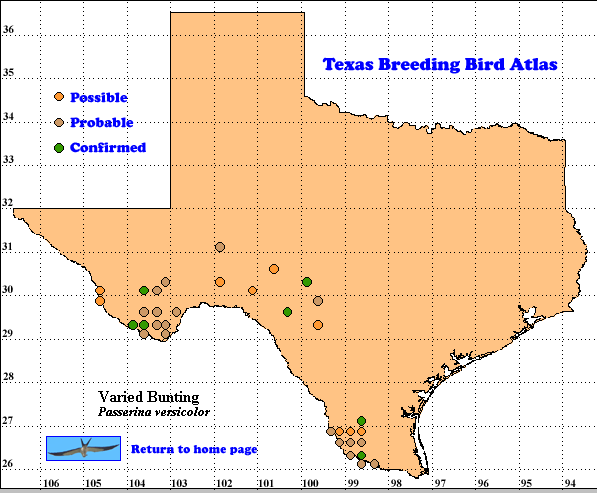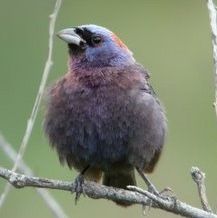While Varied Buntings are fairly common to common in Mexico where most of the species breeds (Howell and Webb 1995), the population in Texas is locally uncommon to rare (Lockwood and Freeman 2004). The population has apparently decreased greatly since the 1870s , at least in some areas of Texas (see Status below). In southeast Arizona Varied Bunting is considered a locally common breeding species within its nesting season of early July to early September, which coincides with summer rainfall (Rosenberg and Stejskal 1999, Corman 2005). In Arizona the breeding habitat of this bunting has been degraded rather than destroyed, probably accounting for the difference in abundance between the two states..
DISTRIBUTION. During the 1987-1992 field work of the TBBA project, atlasers found confirmed breding evidence for Varied Bunting in 3 areas, the Big Bend (latilong-quad 29103-C5 & D8 and 30103-A5), the Edwards Plateau (29100-E4 and 30099-E7) and the lower Rio Grande valley (26098-C5 and (27098-A5). In addition 23 probable and 15 possible records were found around these locations. Earlier the species was considered fairly common (some years) and breeding was reported in the Guadalupe Mountains and along the Rio Grande River between Big Bend and the lower valley in addition to the areas reported by TBBA observers (Oberholser 1974).
This bunting also breeds in southern Arizona and New Mexico, almost all of mainland Mexico south to the Isthmus of Tehuantepec, southern Baja California and the highlands of Chiapas, Mexico and Guatemala. Buntings breeding in the United States and the highlands of northern Mexico move south or to lower elevations in winter (Howell and Webb 1995, Grosschupf and Thompson 1998, Corman 2005).
SEASONAL OCCURRENCE. Spring migration of Varied Buntings occurs between April 6 and June 26 with most arriving from mid-April to mid-May. The breeding season in Texas extends from mid-April to mid-July, based on egg dates from April 26 to July 7. Southward movement takes place from June 10 to September 6 with the peak from mid-July to late August (Oberholser 1974).
BREEDING HABITAT. Varied Buntings breed in Texas from near sea level to 1600 m (5300 ft) in dense, thorny brush, generally on a slope in an arid climate (Oberholser 1974). In Arizona the species breeds along perennial and intermittent streams in vegetation ranging from sycamore, cottonwood and willow to mesquite paloverde and ironwood (Corman 2005).
The nest, placed in a bush, vine tangle or low tree is a compact cup of dry grass, small forb stems and soft materials, lined with rootlets and fine grasses. Eight nests in Cameron County were placed in small bushes, 0.4-1.5 m ((1.3-5 ft) above ground (Harrison 1979).
The female lays 3-4 bluish white to white, unmarked or lightly spotted eggs. Unmarked eggs are indistinguishable from eggs of Indigo (P. cyanea) and Lazuli (P. amoena) buntings. The eggs are incubated for about 14 days and the young remain in the nest for at least 10 days. Parasitism by Brown-headed Cowbirds (Molothrus ater) is not uncommon. (Harrison 1979, Grosschupf and Thompson 1998).
STATUS. The Breeding Bird Survey does not sample Varied Buntings in Texas for population trend data. Data from Arizona are too limited to be useful (Grosschupf and Thompson 1998). Numbers in Cameron County have dropped since the late 1870s, when the bunting was abundant (Merrill 1879) to fairly common (Griscom and Crosby 1926), and rare (Wolfe 1968). No confirmed breeding was found in this county by TBBA field workers in 1987-1992. This decrease is probably due to habitat loss (Grosschupf and Thompson 1998). Text by Robert C. Tweit (2006)
 Literature cited.
Literature cited.
Corman, T. E. 2005. Varied Bunting (Passerina versicolor). In Arizona breeding bird atlas. pp. 550-551 (T. E. Corman and C. Wise-Gervais, eds.), University of New Mexico Press, Albuquerque.
Griscom, L. and M. S. Crosby. 1926. Birds of the Brownsville region, southern Texas. Auk 43: 18-36.
Grosschupf, K. D. and.C. W. Thompson. 1998. Varied Bunting (Passerina versicolor). In The birds of North America, No. 351 (A. Poole and F. Gill, eds.). The Birds of North America, Inc., Philadelphia, PA.
Merrill, J. C. 1879. Notes on the ornithology of southern Texas, being a list of the birds observed in the vicinity of Fort Brown, Texas, from February, 1876 to June, 1878. Proc. U. S. Nat. Mus. 1: 228-234.
Wolfe, L. R. 1968. Varied Bunting. Pp. 132-137 In Life histories of North American cardinals, grosbeaks, buntings, towhees, finches, sparrows and allies. (A. C. Bent and O. L. Austin, Jr., eds.). U. S. Nat. Mus. Bull. 237.
